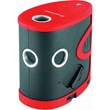
Buyers Guide to Machine Control Receivers
Machine control receivers boost contractors’ productivity by providing grading guidance that ensures extreme accuracy with less manpower and time consumed. There are two ways to use a machine control receiver in the field: through a laser display system and an automatic hydraulic control system.
Laser-Based Display System

In a laser-based display system, the machine control receiver provides on-grade guidance so that you can continue excavating, trenching, whatever it is without the need for another guy to occasionally check grade for you.
This system mostly consists of two main devices: a laser level and a machine control receiver. While the laser level, usually a self-leveling rotary laser, provides a horizontal reference plane, the receiver, which is attached to the machine, gives real-time on-, above-, and below-grade signals.
Automatic Hydraulic Control System

The automatic hydraulic control system takes the display system up to several notches. This system often consists of three parts: the laser level, machine control receiver, and a control box. This time, not only does the machine control receiver keep you on-grade, but it can also control blade height and angle.
The machine control receiver sends the signal it receives from the rotary level to the control box installed inside the machine’s cab. This control box is connected to the machine’s hydraulic system, enabling it to automatically control the machine’s blade/stick. The operator literally just has to drive the machine and the automatic hydraulic control system will do the rest.
As you can see, the machine control receiver plays a vital role in both systems. Let’s now see what you need to look for in a machine control receiver.
Important Features of a Machine Control Receiver

1. Accuracy settings
Machine control receivers usually have several accuracy modes or levels that fit certain applications. Most receivers have four accuracy modes: ultra-fine, fine, medium, and coarse. For rough grading, the coarse mode should do the job while you may need ultra-fine to fine accuracy for final grading. Be sure to check the accuracy modes of a machine control receiver to see if it has the level that you need for various applications.
2. Display channels
Machine control receivers display position information through display channels. The photo to the right shows the 7 channels of AGL’s EZ-Grade 360: 3 above-grade channels, the on-grade channel, and 3 below-grade channels. If the receiver displays an above-grade channel, you have to press the down button, and a below-grade channel means you have to press the up button.

3. Mounting options
Most machine control receivers come with a variety of mounting options, the most common ones being a magnet or clamp. A magnetic mount allows you to easily attach the receiver to the machine’s stick or cutting blade. Receivers can also be attached to manual or electronic masts placed at the front of the machine.

4. Reception area
The detection window or reception area of receivers also differ. Some more advanced receivers 360 window while smaller receivers have somewhere around 240 to 270 windows. The larger the reception area come in handy for large projects, but come with an increase in price.
5. Upgradability
You also have to keep in mind that some machine control receivers can only be used in a laser-based display system while others can also be used for both a display system and an automatic hydraulic control system. Know how you want to use the receiver and decide on a purchase accordingly.
6. Plumb indicator
A plumb or vertical indicator monitors the angle of the machine’s stick and signals if it is overextended, underextended, or plumb. This feature is crucial to avoid over- or under-cutting. For most machine control receivers, this plumb indicator would work within a few degrees of error, with ±5° being the most common range.

7. Memory
Some machine control receivers like Leica LMR-360R can store the last signal received, making second-day setups faster. Receivers with this feature usually have LED arrows that indicate which way to move the bucket/stick to pick up the beam again.
8. Battery Life
Receivers are often powered by NiMH rechargeable batteries or alkaline batteries with battery lives anywhere from 30 hours to 100 hours. You’d obviously want a longer battery life if you tend to work long hours and want to avoid charging downtimes.
9. Protection
You also have to check how protected the receiver is from weather elements. An IP66 rating (dustproof and waterproof) is common for receivers.
Choosing the right machine control receiver is crucial to boosting your productivity and getting the most value for your money. If you need more help in choosing the best receiver, give our experts a call today, and they will be happy to help.


































